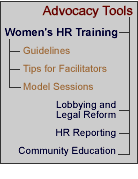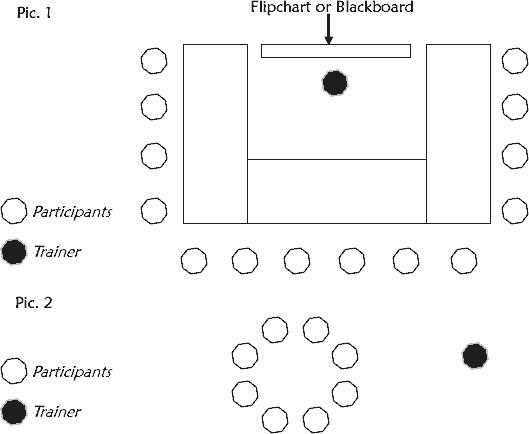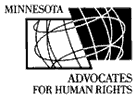|
|
|
ORGANIZING A TRAINING WORKSHOP
Logistical Aspects There are four important logistical considerations in preparing for a training workshop:
ContractsWhen the facilitator is external to the organization requesting training, the facilitator should clearly outline the terms for the training based on the organization’s expectations. Are they expecting research, materials production, running workshops and/or follow up? What time frame is being considered? How much money is available to produce materials, pay for workshop costs and participants’ food and travel costs and to pay the facilitator? It is useful to negotiate the facilitator’s terms of reference which set out in some detail exactly what the facilitator is expected to do and/or produce, to what standard, by when, and at what cost. Administrative SupportIf the facilitator is external to the organization then he/she will need to know how much administrative support can be expected.
The VenueIdeally, the following conditions should be met in respect to the location for a training workshop:
It is advisable to check the training venue in advance for the availability of relevant resources. Check for:
Adapted from Workshop Organization – 5 key aspects, Seafield Research and Development Services (SRDS). Materials and EquipmentThe necessary materials and equipment will depend on the training methods that are used. Some will be needed for preparation (e.g. computer, printer & photocopiers) and others during the workshop itself. No list of materials would ever be complete but here are some ideas to begin with - you can brainstorm and create your own checklist! Materials
Equipment
In case some resources are unavailable, make necessary arrangements ahead of time, or use your creativity to find substitutes to support the training exercises. Suggestions for set-upCertain ways of arranging a room facilitate an open and equal learning environment for all the participants of the training session (including the training team). It is advisable to arrange the furniture so that the participants are able to face one another. This kind of set-up promotes open communication and the sharing of ideas. One common way to facilitate this is to organize the table and chairs in a U-shape, with the facilitator and visuals located in the front, as seen below in Picture 1. Another effective arrangement for smaller groups is a circle, as seen in Picture 2. Chairs should be easily moveable around the room, depending on the conditions and types of training activities (for example, to conduct smaller working groups). Facilitators should use their own judgment for whether or not tables are necessary in the set-ups presented in Pictures 1 and 2. A traditional classroom set-up with tables in rows, however, is generally not effective. A more relaxed set-up is better for encouraging open communication. Two of the most common schemes for arranging tables and participants are illustrated below:
Excerpted from Prevention of Domestic Violence and Trafficking in Human Beings, Training Manual, Winrock International. FacilitatorFacilitators are not teachers in the traditional sense; their role is rather to facilitate the process of learning by the participants, to be an intermediary between new knowledge, fresh ideas and the group. The responsibility of a facilitator is to build a relationship with the group participants. To this end, while working with the group, the facilitator should demonstrate in practice her/his belief in the principles of non-violence and gender equality. In most cases, facilitators work in pairs – as a training team. Facilitators can either be from outside or inside of the organization requesting training. They can also be from the same or a different country or culture than the country of training. Combining inside and outside facilitators as a team creates an especially effective training, as each facilitator brings different skills and knowledge to the sessions. For example, an outside consultant facilitator can bring the overall knowledge and skills for facilitating a training workshop on a particular issue, while the internal facilitators bring knowledge of the organization and the country specifics in relation to the training issue. It is important that the selection of facilitators be based on the following criteria: The facilitator(s) must have:
Briefing of facilitators1) The facilitator should have knowledge of the country’s historical and current background on the topic of training; 2) The facilitator should know which international treaties and laws the country has signed/ratified in relation to the topic of training; 3) The facilitator should be aware of any issues of current concern in relation to the audience being trained. The Tips for Facilitators page offers instructions for the training team before and during the workshop. ParticipantsIt is important to consider the size of the group being trained. If the group is too small (i.e. less than 10 participants) it may be difficult to facilitate discussion. With a larger group, however, the learning process may be slower. The optimal number of participants in a training session is 15-20 persons. It is necessary to consider in advance who exactly needs this particular training and whether the chosen participants are responsible and receptive enough to learn something useful from the session. One of the major training objectives is the creation of equal opportunities for all participants during the training session. Equity and mutual respect among all members of the group (including the facilitators) are essential in fully accepting new knowledge and opinions. The training session should help build trust among the members of the group to each other, the facilitators, as well as to new ideas and new information. In order to better appreciate and digest the learning material, it is important to develop an atmosphere in the group, which will encourage each participant to openly express his or her ideas, and search for answers to questions posed. That is why the training team needs to plan well in advance on how to create equal opportunities for all the participants of the training session. The Tips for Facilitators page offers tips on planning for participants needs. What is a Training | Needs Assessment | Goals and Objectives Organizing a Training Workshop | [Preparing the Training Program] | Conducting Exercises | Training Methods | Tips for Facilitators | [Model Sessions] | Final Remarks |
| Home | Contact | Feedback | Disclaimer |


